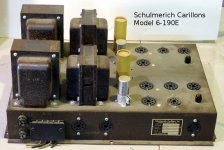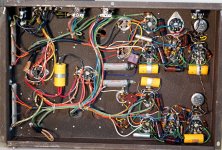Hi everyone-
I am new to tubes.
I have a 1960's vintage Schulmerich audio amp (marked Model 6-190E, evidently used with Carillons) that needs four 5881 output tubes, two for each (independent) channel. I have had no luck finding a schematic, it has not been powered on yet, and I have little knowledge of the actual circuit requirements.
At this point I just would like to attempt to repair it enough to work, then later perhaps improve/tweak. This is a learning project. I have replaced all electrolytic caps and done a few other repairs. I need to buy four 5881's for this. Could you recommend which ones and which supplier?
I have been recommended to Bob Dobush, in Ohio, of findatube.com. He has four used US green print black base Sylvania's for sale for $15 each plus postage. His opinion is that they will sound better than the Sovtek 5881's (through yenaudiostore on eBay for about that same price). He is evidently reputable, and checks his tubes, but I am unfamiliar with what that might actually mean in his case, or what to ask. Maybe you could suggest questions for me to ask him?
I don't want substitutes at this time, i.e. 6L6 variants etc, since the amp is designed for 5881's. And please, if you recommend other suppliers, don't use acronyms- I won't know who you are referring to! $15 is probably as high as I would want to go for these, at this time.
The other tubes are: 6SJ7 and 6SN7. Neither the power supply transformer nor the output transformer are marked with any info. The outputs are 8-pin octal sockets, and I suspect has taps for 70V as well as 16ohm and 6ohm (not sure yet).
Different question, if I may; why would an amp like this require two separate power line inputs, one for each channel?
I am new to tubes.
I have a 1960's vintage Schulmerich audio amp (marked Model 6-190E, evidently used with Carillons) that needs four 5881 output tubes, two for each (independent) channel. I have had no luck finding a schematic, it has not been powered on yet, and I have little knowledge of the actual circuit requirements.
At this point I just would like to attempt to repair it enough to work, then later perhaps improve/tweak. This is a learning project. I have replaced all electrolytic caps and done a few other repairs. I need to buy four 5881's for this. Could you recommend which ones and which supplier?
I have been recommended to Bob Dobush, in Ohio, of findatube.com. He has four used US green print black base Sylvania's for sale for $15 each plus postage. His opinion is that they will sound better than the Sovtek 5881's (through yenaudiostore on eBay for about that same price). He is evidently reputable, and checks his tubes, but I am unfamiliar with what that might actually mean in his case, or what to ask. Maybe you could suggest questions for me to ask him?
I don't want substitutes at this time, i.e. 6L6 variants etc, since the amp is designed for 5881's. And please, if you recommend other suppliers, don't use acronyms- I won't know who you are referring to! $15 is probably as high as I would want to go for these, at this time.
The other tubes are: 6SJ7 and 6SN7. Neither the power supply transformer nor the output transformer are marked with any info. The outputs are 8-pin octal sockets, and I suspect has taps for 70V as well as 16ohm and 6ohm (not sure yet).
Different question, if I may; why would an amp like this require two separate power line inputs, one for each channel?
Attachments
Personally I would use a set of cheap soviet 6P3S-E for my initial testing.
The two power lines are possibly for each channel (easy to verify) or possibly one for the amp and a feed-through for the preamp.
Post some photos of the underside.
The two power lines are possibly for each channel (easy to verify) or possibly one for the amp and a feed-through for the preamp.
Post some photos of the underside.
Hi,
If you haven't done so, change out the black capacitors with the red writing on them; especially the ones that connect to pin 5 of the 5881 sockets. They become leaky and are the main culprit for destroying output tubes.
The way the amp is laid out, it looks like a dual mono amp on one chassis. Very neat.
Hope this helps...
Daniel
If you haven't done so, change out the black capacitors with the red writing on them; especially the ones that connect to pin 5 of the 5881 sockets. They become leaky and are the main culprit for destroying output tubes.
The way the amp is laid out, it looks like a dual mono amp on one chassis. Very neat.
Hope this helps...
Daniel
Hi Dan- OK. I assume those with the red lettering are mylar, and might not need replacing... but I do expect to check all of them at some point. I certainly didn't know about those particular ones contributing to the demise of the output tubes, so that's a definite. Thanks!
TheGimp- yea, OK, that's possible. With these power amps (to me) it seems silly to quibble over the cost of power, but then again, if these were used for Carillons it may be that one channel was left on 24/7? I just wanted to make sure there wasn't some electrical reason. Since I plan to modify these for home use, I might as well remove that option and use something more convenient and common.
TheGimp- yea, OK, that's possible. With these power amps (to me) it seems silly to quibble over the cost of power, but then again, if these were used for Carillons it may be that one channel was left on 24/7? I just wanted to make sure there wasn't some electrical reason. Since I plan to modify these for home use, I might as well remove that option and use something more convenient and common.
Hi Dan- OK. I assume those with the red lettering are mylar,
They are paper caps and usually go bad because of age. As a rule of thumb, they get replaced because more often than not they are leaky.
They orange/yellow ones are probably bad also. Electrolytics...
A Sovtek 5881 has slightly larger Anode and can dissipate an extra 5Watts as a result. Apart from that they are electrically similar to a 6L6GC.
Last edited:
Looking at the photo of the bottom it looks like the bias voltage is taken to the output sockets (blue wires from output tube sockets connected to the bias pots).
That should make it easy to adjust the bias for whichever tubes you install but it is done per pair, not per individual tube.
If there is enough latitude in the adjustment you may be able to bias it for the lower dissipation 6L6s (23W).
That should make it easy to adjust the bias for whichever tubes you install but it is done per pair, not per individual tube.
If there is enough latitude in the adjustment you may be able to bias it for the lower dissipation 6L6s (23W).
Totally conjecture, but I suspect to save power when using one channel as a mono amp.
My guess is they wanted 100% redundancy - if anything fails, there's another full unit ready to go... the chimes must go on or nobody will know it's lunch time!
Hmmm, I'm so glad you mentioned that. I'm assuming (until corrected) that blue line leading away from the 1/2meg (parralleled) pots is the input.
What you can't see in the photo is that there are two blue lines- one goes from the pot to pin4 of the 6SJ7, the other blue line goes from pin6 of the 6SN7 to the output connector.
The input is evidently going into what's marked as "booster" on the front, then attenuated by those pots. It's a two-channel mono- a single signal splits at the pots, which are in parallel.
Which poses the next question- how does one set the bias on this? I'm guessing there is no control for bias, but again I'm new to tubes.
Here is a photo from a similar vintage schematic from a _different_ Schulmerich amp (preamp), I'm wondering if it reveals some clues about my outputs.
What you can't see in the photo is that there are two blue lines- one goes from the pot to pin4 of the 6SJ7, the other blue line goes from pin6 of the 6SN7 to the output connector.
The input is evidently going into what's marked as "booster" on the front, then attenuated by those pots. It's a two-channel mono- a single signal splits at the pots, which are in parallel.
Which poses the next question- how does one set the bias on this? I'm guessing there is no control for bias, but again I'm new to tubes.
Here is a photo from a similar vintage schematic from a _different_ Schulmerich amp (preamp), I'm wondering if it reveals some clues about my outputs.
Attachments
So, no other opinons? If I were to buy used 5881's or, as TheGimp suggests, 6P3S-E's, which vendors do you recommend? When buying used tubes from a vendor you don't know, what questions do you ask them?
Jim McShane Vacuum Tubes is a good guy to get well tested tubes from and he has those Russians mentioned.
Tube & Information Page
Tube & Information Page
Last edited:
I've heard good things about Bob (Findatube.com), if you want the 6P3S-Es, I'd go to Jim McShane Tube & Information Page Same tube is sold as 5881 - really is equivalent to 6L6GC, rated higher than 5881. All variants of the 6L6 are interchangeable, as long as you use one rated the same or higher. Needless to say, none wil last long at their maximum ratings.
6L6, 1622, 6L6G, 6L6GA, 6L6GB: 19W
5881: 23W
1614: 25W
6L6GC, 7581: 30W
7581A, 7027: 35W
6L6, 1622, 6L6G, 6L6GA, 6L6GB: 19W
5881: 23W
1614: 25W
6L6GC, 7581: 30W
7581A, 7027: 35W
Thanks Tom. If there's not much price difference, I think I will get the 5881's from Bob- he's out of town currently but let me know he will get back to me. I have only bought one order from him, but he seems responsive and reputable.
- Status
- Not open for further replies.
- Home
- Amplifiers
- Tubes / Valves
- Selecting 5881's question


